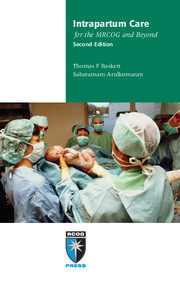Book contents
- Frontmatter
- Contents
- Preface
- Abbreviations
- 1 Improving intrapartum care
- 2 First stage of labour
- 3 Second stage of labour
- 4 Fetal surveillance in labour
- 5 Third stage of labour
- 6 Lower genital tract trauma
- 7 Induction of labour
- 8 Preterm labour and prelabour rupture of membranes
- 9 Assisted vaginal delivery
- 10 Shoulder dystocia
- 11 Breech vaginal delivery
- 12 Twin and triplet delivery
- 13 Caesarean section
- 14 Vaginal birth after caesarean section
- 15 Uterine rupture
- 16 Emergency obstetric hysterectomy
- 17 Cord prolapse
- 18 Antepartum haemorrhage
- 19 Postpartum haemorrhage
- 20 Acute uterine inversion
- 21 Amniotic fluid embolism
- 22 Disseminated intravascular coagulation
- 23 Acute tocolysis
- 24 Severe pre-eclampsia and eclampsia
- 25 Neonatal resuscitation
- 26 Perinatal loss: management of late fetal death and stillbirth
- Index
22 - Disseminated intravascular coagulation
Published online by Cambridge University Press: 05 July 2014
- Frontmatter
- Contents
- Preface
- Abbreviations
- 1 Improving intrapartum care
- 2 First stage of labour
- 3 Second stage of labour
- 4 Fetal surveillance in labour
- 5 Third stage of labour
- 6 Lower genital tract trauma
- 7 Induction of labour
- 8 Preterm labour and prelabour rupture of membranes
- 9 Assisted vaginal delivery
- 10 Shoulder dystocia
- 11 Breech vaginal delivery
- 12 Twin and triplet delivery
- 13 Caesarean section
- 14 Vaginal birth after caesarean section
- 15 Uterine rupture
- 16 Emergency obstetric hysterectomy
- 17 Cord prolapse
- 18 Antepartum haemorrhage
- 19 Postpartum haemorrhage
- 20 Acute uterine inversion
- 21 Amniotic fluid embolism
- 22 Disseminated intravascular coagulation
- 23 Acute tocolysis
- 24 Severe pre-eclampsia and eclampsia
- 25 Neonatal resuscitation
- 26 Perinatal loss: management of late fetal death and stillbirth
- Index
Summary
Disseminated intravascular coagulation (DIC), also known as con sumptive coagulopathy, is a syndrome characterised by abnormal coagulation and fibrinolysis. DIC is acquired secondary to certain complications of pregnancy. A more detailed definition has been proposed by Bick: ‘A systemic thrombohemorrhagic disorder seen in association with well-defined clinical situations and laboratory evidence of (a) procoagulant activation, (b) fibrinolytic activation, (c) inhibitor consumption, and (d) biochemical evidence of end-organ damage or failure.’
Pathophysiology
Haemostasis is a dynamic balance between coagulation, which leads to fibrin formation, and fibrinolysis, which disposes of the fibrin once it has performed its coagulation function. During normal pregnancy there are progressive and profound changes in both of these systems. The pro-coagulation factors 5, 7, 8, 9, 10, 12 and von Willebrand's factor all rise significantly. Fibrinogin levels are increased two-fold. These procoagulation changes, along with the increased blood volume, prepare the woman for blood loss at delivery and serve to produce haemostasis at the large uterine site of the separated placenta.
In DIC, there is excessive and generalised coagulation owing to the release of tissue thromboplastins into the maternal circulation. This causes excessive consumption and eventually depletion of the coagulation factors. Secondary to this widespread coagulation and deposition of fibrin in the microvasculature, the fibrinolytic system is activated. The breakdown of fibrin forms fibrin degradation products (FDP) which inhibit both fibrin and platelet function, aggravating the coagulation defect.
- Type
- Chapter
- Information
- Intrapartum Care for the MRCOG and Beyond , pp. 239 - 244Publisher: Cambridge University PressPrint publication year: 2011



